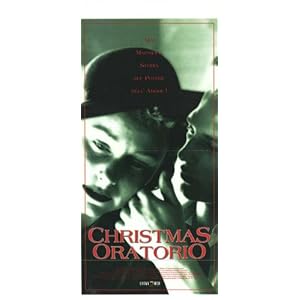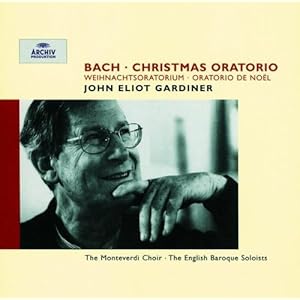

 字體:小 中 大
字體:小 中 大 |
|
|
|
| 2011/08/15 22:50:07瀏覽1320|回應0|推薦0 | |
|
無以名狀的喜悅 ~~ 淺解巴哈的『聖誕神劇』, 2004.1.25 詩篇33:1~3 義人哪,你們應當靠耶和華歡樂;正直人的讚美是合宜的。你們應當彈琴稱謝耶和華,用十弦琴歌頌他。應當向他唱新歌,彈得巧妙,聲音洪亮。   同名 電影
^^^^^^^^^^^^^^^^^^^^^^^^^^^^^^^^^^^^^^^^^^^^^^^^ 同名 電影
^^^^^^^^^^^^^^^^^^^^^^^^^^^^^^^^^^^^^^^^^^^^^^^^下面這篇曾慶豹先生的文章真好,比我寫的『聖誕神劇』簡介好上百倍。 巴哈投入宗教音樂的方式真正身體力行----從他生得出20個娃兒看來,他不胡搞男女關係,性病不上身,而感人至深的神劇,都完成在青梅竹馬的第一任老婆過世之後。我們沒有看到懷憂喪志,而是由「約翰受難曲」的激昂轉為「馬太受難曲」的平和再轉為「聖誕神劇」(與B小調彌撒) 的感謝歡喜。這樣的力量來自信心不滅,我們因為巴哈對上主的信心不滅,間接得到神恩──巴哈不朽的音樂。  St. Thomas Church, Leipzig_bach “不要忘記大地是上帝用「說」的方式創 造的,因此在人與上帝之間,存在著某種非文字、非說話的語言,一種只有人可以進入神聖家園的語言。” 曾慶豹先生這句話,恐怕所有的愛樂人都必須承認,音樂,的確正是某種神秘力量向我們”說---SPEAK”出來的! 下文我唯一稍能提出異議的,是第五段談及數學與神學關係的部份 a 我想如果比喻為 ”科學家(實證科學)對神學與古典音樂” 不可抗拒的興趣,應該更恰當,因為數學是最早成熟的科學,故希臘當時最可能有此感覺的自然是數學家。 至於為何「聖誕神劇」讓我感動異常,這牽涉到與上述三大神劇相類似的心情轉折,我想,巴哈也是在新的家庭出現後,嫻熟樂音的妻子更為琴瑟和鳴,加以失去雙胞胎後又喜得新生兒,新的溫暖,更加堅信上蒼眷顧。( p.s.巴哈三大神劇,指「馬太受難曲」(St. Matthew Passion)、「約翰受難曲」(St. John Passion)與「聖誕神劇」(Christmas Oratorio)。) 從 Sars剛完的"Tristan und Isolde"到上回的"La Damnation de Faust",我都看到溫文儒雅的李明亮前署長出現歌劇院,灰常灰常”與有榮焉”,更欣見上一次的拐杖已經拋開了! 最近很愛巴哈,十多年前,只有莫札特的『安魂曲』可以同時觸動理智與情感的深度,大悲大喜是那個年齡世界的節奏。 五年前於巴哈『馬太受難曲』中,開始學習平和接受上蒼的試煉,並且在「看」、「淚」等旋律安排中體會出凡人對真理的嚮往。 而Christmas Oritoria,這齣寫在更晚期(約1734-35左右)的神劇,是浸淫路德教會已久的巴哈晚年,對有如他人生的全部宗教生活的一個體驗的釋放。 ''猶如Goldberg Variation在平凡中彰顯自己音樂上不朽成績的意圖,巴哈雖然用清唱劇 ( Cantata ) 混飯多年,(速度竟可以快到一週一首) ,還是認真地把其中的某些旋律重組為幾首重要的教堂聖樂,依序為( 形容詞引用自智庫出版的巴哈傳) : 【1】BVW245 聖約翰受難曲 【2】BVW 244聖馬太受難曲(其中喪禮段落當年初先用在知音好友Leopold 王子的喪禮,沒有聖約翰受難曲的憤怒衝突,只有適懷與安祥 【3】BVW 247 聖馬可受難曲--佚失 【4】BVW 232B小調彌撒曲--聖誕神劇前的「垂憐經」Kyrie與「光榮頌」Gloria出自此,1733寫給信奉羅馬天主教的奧古思都二世之死與預祝三世之登基( 起先是巴結新王之用、非奉命作曲,直到1736獻上第二首清唱劇後,巴哈才被三世頒為皇家作曲家) ,合併後在奧古思都三世正式登基時演奏。樂曲結構更繁複,合唱與敘述緊密結合,不斷地變奏,卻又使整體表現完整呼應,並加入男童聲「無伴奏聖詠合唱」Cantus Firmus。長達三個多小時,只好改在下午1:15教堂鐘響開始,是巴哈教堂音樂的巔峰作! 【5】BVW 248 聖誕神劇--1734首演,重復取材(Parody—形容當時這種常用的作法) ,利用到之前為奧古思都三世創作的另三齣清唱劇,規模中有6首Cantatas,在聖誕時期分6天演出,把耶穌誕生的整個過程演出。如第三部份牧羊人的部份借自BWV214/9,決定前往伯利恆的聖詠 (Chorale)後的雙重唱,借用BWV 213/11等等,至少11段來自他以前為非教堂場合寫的三首secular cantata。 聽一小段,你會了解到為什麼它如此讓人接近天堂。 第一天第一段* 值得慶賀的好日子 “ Rejoice, exult! Up, glorify the days,/ Praise what the All highest this day has done/ Set aside fear, banish lamentation, strike up a song full of joy and mirth!/ Serve the All Highest with glorious choirs! Let us worship the name of the Lord!” 在電影中反覆出現,像是家族的傳承,苦樂參半中才能嘗出滋味的人生喜悅。  巴哈時代音樂背景 遠在巴哈(1685 - 1750)之前,十七世紀初Monteverdi( 1567-1643) 已為歌劇的開始成就了番新氣象,那些繁瑣的曲式變化與不和諧音,儼然已經是「現代音樂」的先端。但是17世紀前教會認為人聲是惟一莊重的音樂,17世紀中到18世紀器樂才有幾個形式開始固定下來—— 拜“ Sonata” (器樂曲) 之賜,Cantata一字也開始出現(歌樂曲)——在巴洛克時代它代表一個包含詠嘆調、宣敘調、合唱、聖詠的作品。由於馬丁路德把「聖樂清唱劇」當作教會的核心。當時德國小國林立,每個小邦國都有宮廷樂手,因30年戰爭藝術創作停擺,四周各國音樂入侵,在德國大融合 (1)法國巴黎聖母院樂派開創了複音音樂:運用葛利果聖歌為基礎,試圖利用技巧結合兩個以上旋律(即對位法),法國新藝術大師Machaut(1300-1374)的彌撒曲中(CYPRES 1630)可以見到 (2)法蘭德斯樂派的大師Desprez(1440-1521)的經文歌中(CYPRES 1630) :同時處理多旋律的技巧,加入模仿風格,使各聲部交互「模仿」主旋律,使音樂有一種連綿不斷之感,此即是賦格之始。 (3)18世紀義大利也出現有大鍵琴等數種樂器solo與人聲solo的「室內樂」——宣敘調(Recitatives)與詠嘆調(aria)出現。逐漸地,Cantata變成由宣敘調串連數首詠嘆調的形式。當時「聖樂清唱劇」與歌劇很難區分差距,正如「神劇」和大型「聖樂清唱劇」也很難區分。不過『聖誕神劇』的劇情安排完整性使它變成一個不可分的作品。 巴哈初寫Cantata,很長一段時間掙扎在德國管風琴大師、義大利與法國曲風之間,許多他任職的小教會嫌他花俏大膽,幸而他管風琴近乎獨步天下,還會修管風琴,才能不 斷找到新老板。1723任萊比錫聖湯瑪斯教堂合唱長,必須不斷為萊比錫各個教會寫作教會音樂、指導禮拜時的學生演唱,還兼附設學校的音樂教師,非常忙碌。起初數年,巴哈每週為教會寫作新曲,教會清唱劇大都在這時譜出。但正因1720丧妻時他從世俗清唱劇回歸宗教,一年後與年輕歌手瑪格達蕾娜再婚,他更加珍惜家庭與性靈生活。 巴哈對管風琴音樂的影響也承先啟後,除反映巴洛克時代音樂外,也有個人的內涵與苦學。1717年完成了「管風琴手冊」(Orgelbuchlein),是按全年教會年曆(das Kirchenjahr)來編排所需用的風琴短曲樂集,獻詞「獻給上帝以示虔敬」,其中音樂與歌詞密切聯繫,對聖詠曲的貢獻極大。巴哈自小生長地區屬於路德教派,他們鑽研聖經,相信透過音樂傳達信仰上的神聖。巴哈卻教導學生們擺脫羈絆,但要保持音樂的邏輯性,他利用作曲技巧重複使用一些動機樂句(Motive),表達信仰的引申,如:快樂、哭泣、昇天,或運用下行音階預示基督化成肉身降臨人間等等。 時代宗教背景 教皇葛利果一世(Gregory the Great, 590-604)制訂了「葛利果聖歌」,使得中世紀晚期一直被命名為「葛利果聖歌」時期。至第九世紀,又孕育出複音音樂。由「聖詠」所啟示的形式與精神,在巴哈身上達到它光榮的頂點,也成為後世德國作曲家的音樂典範。路德的「聖詠」大多來自樸實的民間,德國「聖詠」在馬丁路德後,又受法蘭德斯樂派的洗禮,巴哈的管風琴聖詠曲中,「聖詠」在天主教音樂技法架構上發揮出他深信的新教精神。 本劇特點 很難說它不是宗教音樂,但是由於它維持並彰顯了馬丁路德流派的主張--「反原本天主教音樂的華麗繁複,旋律質樸簡短,以質樸簡單德文為詞,不再侷限於特定的經文」,網評咸認它有種超越宗教的喜悅,或者是生之喜悅,或者是樂音的純然喜悅。 內容上,巴哈寫受難曲時仍是依照福音書內容,『聖誕神劇』則原本是要從聖誕前四週起的將臨期”Advant Garde”到1月6日共6個主日演出,角色--Evangelist(寫福音書的人)、Angel(天使)、Echo、Herodes、solonist(代表各個人,soprano、mezzo-soprano、tenor, base)、Choir、3 trumpets, kettle drums, 2 French horns, 4 oboes, 2 flutes, 1 bassoon, strings, and continuo The Evangelist (傳福音者Tenor soloist) -- tells the story using familiar text from the gospels of St Luke and St Matthew.The drama is enhanced further by soloists performing the roles of the Angel (Part II) and Herod (Part VI). The chorus also contribute, singing the parts of the heavenly host in "Glory to God" (Part II), he shepherds in "Let us, even now, go to Bethlehem" (Part III) and the Wise Men in "Where is this new-born child; the King of the Jews?" (Part V). 他選擇部份路克福音,部份馬太福音為基礎,還用了句路德的詩作。複雜的角色之間的對唱,穿插推展著劇情,一點都不死版,好像巴哈其實很想寫部歌劇,只恨萊比錫的酷約綁死他的觸角。” The cantata as a musical form had originated in Italy: it tells a story in song, whether secular or sacred. It was composed in clearly marked sections of contrasting musical character to match the narrative of the text. The sections are sung by soloists or choir, accompanied in the early years by continuo, and later on by full chamber ensembles. In Germany, the cantata was mainly used to express sacred themes, with soloists 'reciting' biblical text (recitative) and singing poetic texts (arias). The choir contributed with choruses, often of praise, and some in da capo (repeated) form. Bach's church cantatas are the pinnacle of the form, and in the Christmas Oratorio he achieved a remarkable synthesis of the cantata and the more dramatic qualities of an oratorio.” 音樂上劇中銅管的使用明亮歡愉,這是非常德國的,幾乎是別的聖歌所見不到( 其他 B小調彌撒的Gloria、聖母讚主曲也有銅管的大量運用) ,而遵循路德原則的聖詠於此更是一大貢獻 ” Most of them are set simply, with the sopranos leading the congregation in the melody.”” Parts I, V and VI begin with extended choruses, and Part III opens and closes with the same grand chorus.” 而我被其間許多巴哈少見的單純所感動,這些旋律之美,引領我們認識巴哈溫柔與欣悅的一面” child-like simplicity (for instance "Behold! Within a humble stall" in Part II and "Beside Thy cradle here I stand" in Part VI), reflect the glory of the Christ child ("Thy glorious face drives gloom away" in Part V) or it can be more devotional in character "Let me love Thee, King supernal" in Part III.” 他也細心地帶入民間風味” The orchestral colours are extraordinary. For example, each time you hear a chorale for four voices in the first three cantatas--those for Christmas itself--the flutes play the melody along with the singers, which adds an unusual sparkle.” 巴哈的宗教LEITMOTIVE – 本劇出現的parody 其實對當時聽眾而言已帶著原本的意義,如第一天部份在福音說書人提到基督的降生,第一次聖詠出現隨即帶出『馬太受難曲』中基督受難的部份預示未來”The first chorale of the first cantata, for example, comes right after the Evangelist's announcement of the birth of Jesus. Everyone associates the melody of this chorale, repeated five times in five different ways in the St. Matthew Passion, with the theme of Christ's passion. For audiences of Bach's time it was a signature tune, a theme that couldn't be associated with anything else. There is a further consciously theological element in choosing this chorale: the newborn child will die for us.” 因此越熟悉巴哈者如PACO,才能與巴老做真正的精神交流。 死前數年的巴哈對降生的喜悅,和莫札特凡人對死亡與天堂的敬畏,真是天差地遠地兩個極端。The chorale melodies are more closely woven into the fabric of the piece when Bach includes chorale prelude movements. These movements (for instance the final movement of Part I) involve a clear statement of the chorale melody sung by the choir, but with a much-expanded orchestral accompaniment. Bach concludes the entire work with one of these movements: "Now vengeance has been taken" and the Oratorio ends with the final triumphant message: "Henceforth shall Mankind revel before His heavenly throne." 巴哈對6的安排-- The rule of six 。本劇之Cabtat 1.3.6為D大調,適合trumpets的光明調性,餘為Cantata2牧羊人安靜詳和的G大調,逐漸在4.5轉比較確定的A大調。這是述說正面故事時的刻意安排。"Choosing to write six cantatas wasn't a mere whim. Bach liked to group his work by sixes: six concertos for several instruments (which became the Brandenburg Concertos), six suites for solo cello, six works for solo violin, six keyboard partitas, six French suites, and six English suites. Although the cantatas are distinct, a clear key structure is evident. The first, third, and sixth cantatas are written in D major, a key associated with trumpets, royalty, and the baroque idea of power and jubilation. His choice of keys is also significant in terms of affect theory, a language code easily accessible to musicians and even to Bach's audiences. The second, pastoral cantata, which focuses on the shepherds, is in the key of G major, a restful, sub-dominant key. The second-to-last cantata moves back to the dominant, much more assertive key of A major. Bach leaves nothing to chance: everything proceeds according to a careful plan. I'm convinced that, at the end of these six cantatas, listeners will feel as though they've been on a journey and completed an itinerary, rather than having heard a sequence of movements. " 我買的這輯一般評5星PolyGram –Gardiner指揮The English Baroque Sololists & The Monteverdi Choir,個人覺處理不錯,很像電影用的版本,參考一下。 http://youtu.be/ggm0SZCWKZo 註--馬丁路德(Martin Luther, 1483-1546, 上為46歲時):馬丁路德原是羅馬天主教教會神父,受過完整羅馬天主教神學訓練,並是神學院教授。在幾位宗教改革神學家中,他的音樂素養相當好,也能彈彈奏魯特琴(Lute)。但是他的還是提出九十五條(95 Thesen)反對羅馬天主教的神學觀點,包括反對在崇拜時使用管風琴。他鼓勵路德會教會自由地發展會眾音樂,在他的教會裏管風琴只是替會眾唱無伴奏時起音及聖詠曲時交替彈幾小節。由於印刷樂譜相當昂貴,路德教會並沒有很多的讚美詩集,彈管風琴的人必須在會眾唱詩前彈奏很多次,使他們熟悉旋律,這反倒也是新教在管風琴音樂上的意外貢獻。而唱詩前起音的習慣,後來漸漸演變成『聖詠前奏曲』(Choralprelude)及『風琴聖詠曲』(Orgelchorale),管風琴擔任帶領會眾唱詩的角色。有時先彈奏聖詠前奏曲,然後接著唱無伴奏的聖詩。
|
|
| ( 不分類|不分類 ) |












